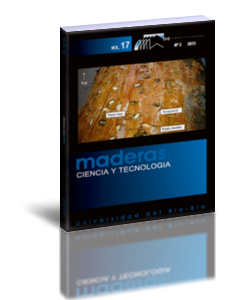Physical and mechanical properties of nanoreinforced particleboard composites
Keywords:
nanoparticles, nanoreinforced adhesives, nanoscience, nanotechnology, particleboard, wood compositesAbstract
Novel composite materials having desired performance properties can be developed by nanotechnology. The major objective of this research was to produce nanomaterial-reinforced particleboard composites with enhanced physical and mechanical performance. Urea formaldehyde adhesive used to produce particleboard composites was reinforced with nanoSiO2, nanoAl2O3, and nanoZnO at loading level of 0%, 1%, and 3%. To evaluate physical properties density, thickness swelling, water absorption, and equilibrium moisture content were determined while modulus of rupture, modulus of elasticity, bonding strength, and screw withdrawal strength tests were carried out to evaluate mechanical properties of the particleboard composites. The results acquired in this work revealed that nanomaterial reinforcement technique significantly affected the physical and mechanical performance properties of the particleboard composites. The findings showed that the modulus of rupture, modulus of elasticity, bonding strength, and screw withdrawal resistance of the composites improved by all the nanomaterials used in this study, except 3% nanoZnO. It was also determined that using 1% nanoSiO2 or 1% nanoAl2O3 in the composites had the best results in the bonding strength and screw withdrawal resistance. The findings indicate that it is possible to produce novel wood composites by using proper nanomaterial type and loading level.
Downloads
Downloads
Published
How to Cite
Issue
Section
License
Copyright (c) 2015 Zeki Candan, Turgay Akbulut

This work is licensed under a Creative Commons Attribution 4.0 International License.
Los autores/as conservarán sus derechos de autor y garantizarán a la revista el derecho de primera publicación de su obra, el cuál estará simultáneamente sujeto a la Licencia de Reconocimiento de Creative Commons CC-BY que permite a terceros compartir la obra siempre que se indique su autor y su primera publicación esta revista.
































